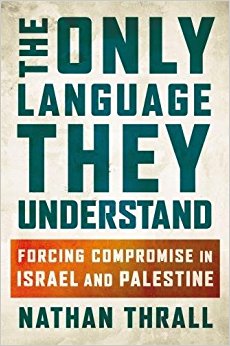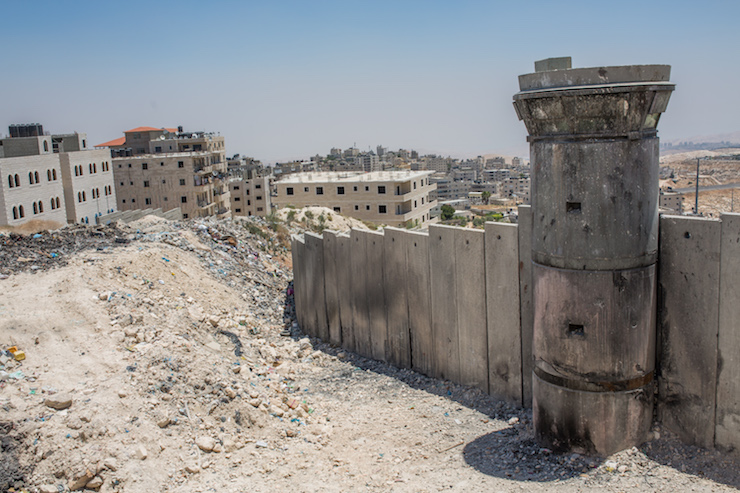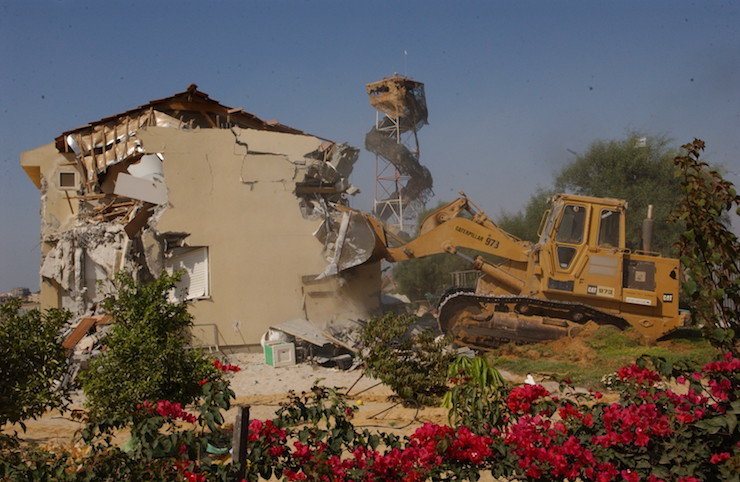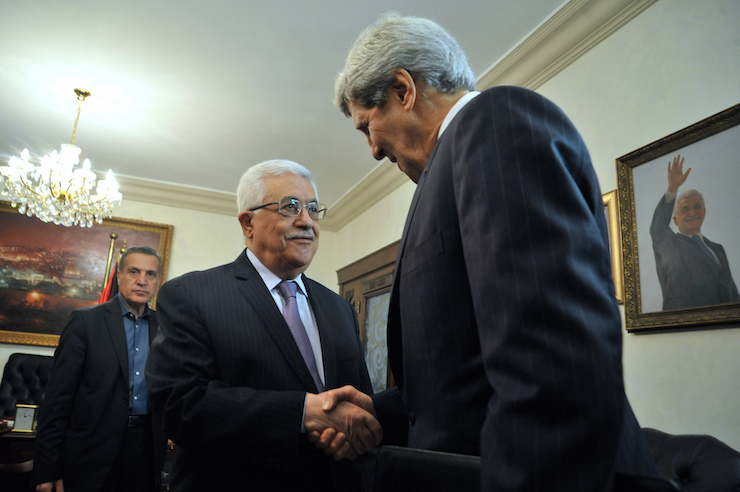Israelis and Palestinians have grown the furthest apart during periods of quiet; it is in times of violence that the two nations have suddenly become flexible in their positions. That defies everything we tell ourselves about prospects for peace, and everything the world has told Palestinians they must do to achieve it. A review of ‘The Only Language They Understand,’ by Nathan Thrall.

“The Only Language They Understand: Forcing Compromise in Israel and Palestine”, by Nathan Thrall, Metropolitan Books, 2017, 336 pages.
The year 2012 was particularly noteworthy in the history of the Israeli-Palestinian conflict: for the first time since 1973, not a single Israeli was killed in the West Bank. This was also the final year of then-Palestinian Prime Minister Salam Fayyad’s state-building project, celebrated by the international community, and even by Israel.
Theoretically, that should have led to a breakthrough in the peace process, at least as far as the West Bank was concerned. Conventional wisdom in Israel and in the world said that the violence and corruption that flourished under Arafat’s leadership were the main determinants in the collapse of peace talks and the meltdown of an Israeli “peace camp,” by virtue of the disappointment and lack of trust they created on the Israeli side. But after Arafat, in 2012, the two men in charge of the Palestinian Authority were: Mahmoud Abbas, who all but ignored Israel’s military operations in the Gaza Strip and saw security coordination with Israel as sacred (as he reportedly told a delegation of Israeli peace activists in 2014), and Prime Minister Fayyad, whose main focus was institution-building, and who refrained from almost any type of confrontation with Israel.
Instead, the exact opposite happened: Israel’s interest in the peace process completely died out. Prime Minister Netanyahu, who thee years earlier agreed under the duress of American threats to the idea of a Palestinian state, began laying more and more obstacles in its path. Recognition of Israel as a Jewish state was added as a new “core issue” in negotiations. Netanyahu’s demand that Israel maintain complete freedom of military action in a future Palestinian state hollowed out the very idea of Palestinian sovereignty. “Economic peace,” which had been Netanyahu’s proposed alternative to actual peace during the 2009 elections, turned out to be an empty slogan. Settlement construction and expansion continued unabated, and the settler population in the West Bank rose, according to data collected by Peace Now, by around 15,000.
 In the summer of 2012, only 55 percent of Israelis supported peace talks with the Palestinians, compared to around 70 percent at the start of 2003 — the height of the Second Intifada. The Israeli street was putting zero pressure on the government to resolve the conflict; to drive the point home, the Labor Party’s campaign that year completely ignored the Palestinian issue, and the “security” platform it did put forward didn’t include the word “peace” even once. In short, complying with Israel and the international community’s demands didn’t get the Palestinians any closer to their own state, and certainly didn’t bring the occupation any closer to its end.
In the summer of 2012, only 55 percent of Israelis supported peace talks with the Palestinians, compared to around 70 percent at the start of 2003 — the height of the Second Intifada. The Israeli street was putting zero pressure on the government to resolve the conflict; to drive the point home, the Labor Party’s campaign that year completely ignored the Palestinian issue, and the “security” platform it did put forward didn’t include the word “peace” even once. In short, complying with Israel and the international community’s demands didn’t get the Palestinians any closer to their own state, and certainly didn’t bring the occupation any closer to its end.
It has actually been uprisings and the application of pressure on Israel that handed the Palestinians their most significant achievements over the years. On the eve of the First Intifada, Israel rejected the favorable Peres–Hussein London Agreement, which would have handed control of the West Bank back over to Jordan. After the intifada, the Israeli government agreed to negotiate with the PLO for the first time, and agreed to allow its leaders to return from exile to the West Bank and Gaza. The Second Intifada broke the taboo surrounding the withdrawal from settlements anywhere in the greater Land of Israel, ultimately leading with Ariel Sharon’s Disengagement Plan from Gaza; after the Disengagement, Sharon’s (and then Olmert’s) Kadima party won elections on a platform calling for an even broader, and significant, unilateral withdrawal from parts of the West Bank.

In the same vein, the violence in Jerusalem in the summer of 2015 opened up cracks in the consensus about the city’s municipal boundaries, and these days even right-wingers are advocating abandoning Jerusalem’s Palestinian neighborhoods that have been cut off by the separation wall. During quiet periods the two sides grew further and further apart, and it was in times of violence that the two nations suddenly found flexibility in their positions. All that defies everything we tell ourselves about prospects for peace.
The only language they understand
The fact that crisis creates opportunity and that periods of calm entrench the status quo could sound rather trivial in any other diplomatic context. But the Israeli-Palestinian conflict, and even more so the peace process that accompanies it, is immersed in narratives and jargon that are completely divorced from reality on the ground. At the top of the list is the illusion that there are two sovereign entities — an Israeli one and a Palestinian one — in a complicated conflict over borders. In reality, the only sovereign is Israel — the Palestinian Authority is merely charged with managing on its behalf it a population without any rights living within its borders.
The Only Language They Understand: Forcing Compromise in Israel and Palestine, a new book by Nathan Thrall, is one of the more important documents bridging that mythology and reality. Thrall is one of two International Crisis Group analysts in Israel and has lived in Jerusalem with his family since 2011, which means that in addition to closely tracking political elites he also has the intimate and intuitive familiarity of someone who is on the ground, and who is attentive to various social dynamics. (In other words, he knows what it feels like to send your kids to school during an “escalation” in Jerusalem.) His writing is practical and flush with details, manages to escape the self-righteous or preachy tone that characterizes so many analysts, and doesn’t seek to create false equivalencies between the two sides for the sake of political correctness. Thrall examines things from from a realist perspective, which places far greater importance on individuals’ and groups’ actions than their rhetoric or ideological declarations. That, too, is refreshing and overdue.

The first third of the book, from which the title is drawn, focuses on the history of Arab-Israeli peace talks from Camp David until the present day. Thrall demonstrates how external pressure, uprisings, and wars led both sides, Israelis and Arabs alike, to abandon their maximalist positions and adopt compromises that had previously appeared impossible to accept. Even the way that the sides approached basic national and religious values (refugees, Jerusalem, and more) changed when enough external pressure was applied.
For example, the Arab defeats led the Palestinians to accept the existence of the State of Israel, to accept Security Council resolutions 242 and 338, to make due with half of the territory they were promised in the 1947 Partition Plan, to give up (in practice) the demand for a full return of refugees, to give up the demand of a full withdrawal to pre-1967 borders, and to agree to creative solutions like land swaps in order to make things easier for Israeli leaders by reducing the number of settlements they would have to evacuate.
Uprisings and wars led Israel, for its part, to withdraw from the Sinai Peninsula, to leave the security zone in southern Lebanon even though Hezbollah hadn’t been defeated, to agree to autonomy in the occupied Palestinian territories, to recognize the PLO as the representative of the Palestinian people, to withdraw from Gaza, and come to terms with Hams rule there. Yet at the end of the day, Thrall writes, “Palestinians have failed where other Arab nations have succeeded because they never posed a real threat to Israel and were too weak to protect their concessions from further erosion.” The logical conclusion is that all of the international community’s attempts to limit Palestinian pressure on Israel and to get the two sides back to the negotiating table “with no preconditions” actually make an agreement more and more elusive, and undermine the goal of advancing a two-state solution.
With regards to the Americans, Thrall writes, those presidents who confronted Israeli most directly — Eisenhower and Carter — are the only ones who achieved anything in the Middle East. In comparison, the embracing approach of Clinton, Bush and at times Obama, failed to yield a single agreement, primarily because Israel sees the status quo as the most beneficial situation.

One of the best chapters in the book concentrates on the failed negotiations led by Secretary of State John Kerry in 2013-14. Despite clear evidence that the maximum the Israeli government was willing to give didn’t even approach the minimum the Palestinian leadership could sell to their people, Kerry nevertheless believed that his personality and determination could lead to an agreement within nine months (!). Thrall calls it “faith-based diplomacy,” which is just-slightly more polite than “messianic,” the term then-Israeli Defense Minister Moshe Ya’alon was quoted using to describe Kerry’s fervor. Accordingly, the principle effort of Kerry’s “negotiations” were endless talks between himself and Netanyahu, the result of which was a document that seemed far-reaching to Israelis and Americans, but which leaned toward Israel more than Olmert’s offer and even the Clinton Parameters of late 2000. Nevertheless, the Americans were astounded that Abbas rejected it.
It would be remiss, however, to attribute the American obsession with restarting fruitless negotiations between the two sides — talks for the sake of talks — to the naiveté of a few presidents or secretaries of state. The peace process, like everything the United States does in relation to the Palestinian problem, is in many ways a function of the special relationship between Israel and the United States. In its rhetoric, the United States is calling for change but its practices — keeping other countries and international bodies at arms length from the conflict, supporting Israeli military operations, and more — make the U.S. a status quo actor, and futile negotiations make the status quo all the more tenable. As Thrall concludes, “the potential benefit of creating a small, poor, and strategically inconsequential Palestinian state are tiny when compared with the cost of heavily pressuring a close ally that wields significant regional and U.S. domestic power.”
A state that almost was
Two-thirds of the book is a collection of articles and essays that Thrall published over the years, primarily in the New York Review of Books. Most of them are excellent; a few haven’t aged as well. The description of the process that transformed the Palestinian Authority from a state in waiting to becoming part of the Israeli regime is particularly fascinating and important. That said, as somebody who has been following Thrall’s work for years, I would have liked to see more original material in the book, especially about the transition between the Obama and Trump administrations, and the question of whether we are actually entering a new era.
Of slightly less importance, I felt that Thrall at times describes or retells events in a way that allows it to fit the theory. For instance, the correlation between the wave of terrorist attacks in 1994-95 and the accelerated negotiations ahead of Oslo II seems tenuous. Likewise, there is serious evidence that Israeli negotiators believed the goal of the Oslo process to be a Palestinian state, and that their hesitance to state that publicly was primarily borne of domestic political considerations. Even if Oslo has become a brilliant and effective mechanism for managing the occupation, as Thrall points out, there is no proof that was the intention from the get-go — only speculation in hindsight. Either way, it’s not a particularly important debate.
The biggest weakness of a realpolitik analysis is that it treats states as “black boxes” that produce rational outcomes, and tends to have a harder time evaluating internal political and cultural dynamics. Thrall discusses the importance of institutions like J Street and the New York Times in pushing the American government into another round of peace talks that only strengthened the status quo, and he briefly discusses the identity of the American negotiators themselves — but he never delves too deep into those topics. He also barely touches on the rise of the new Israeli Right and the maximalist demands that it has brought into the mainstream. The impression that Israel succeeded at thwarting the two-state solution, in my opinion, opens the door to changes in political dynamics in the not-too-distant future.
The book is important, interesting, an easy read, and it serves as a crucial resource for the most significant core issues that occupy the news cycle — from Jerusalem to Gaza. It also gives original and instructive answers to the failure of the peace process that go beyond simply casting blame on one side or another. But the crisis of the two-state solution is not just a crisis of the the political process which was supposed to result in two states; a major part of it is the crisis over the very idea of statehood, and the disintegration of nationalist societies all over the world. Thrall notes at the end of the excellent analysis which opens his book that, “through pressure on the parties, a peaceful partition of Palestine is achievable.” That might be true, but it’s also reasonable to assume such a result would not be a “final status” resolution but merely the beginning of a new chapter.
This article was first published in Hebrew on Local Call. Read it here. Translated by Michael Schaeffer Omer-Man.

